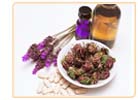Phytoestrogen Herbs
Many plants contain phytoestrogens but these compounds only appear in certain herbs in big enough quantities to be effective in the human body. As the benefits of phytoestrogen herbs become more widely appreciated, many are being turned into supplements which can be more easily consumed. Keep reading below to learn more about phytoestrogenic herbs and to discover the most common herbs containing phytoestrogens.
What are Phytoestrogenic Herbs?
 Phytoestrogen herbs contain phytoestrogenic compounds that, when added to the human body, act as a substitute for the human hormone estrogen. Almost all plants contain some form of phytoestrogen but most have such insignificant levels that they would not have any real effect on the human body. Phytoestrogen herbs contain phytoestrogenic compounds that, when added to the human body, act as a substitute for the human hormone estrogen. Almost all plants contain some form of phytoestrogen but most have such insignificant levels that they would not have any real effect on the human body.
The plants that do contain high levels of phytoestrogen can mainly be found growing wild in pastures and woodland all around the world. As some of these herbs may have poisonous or potentially dangerous chemicals in them, it is important to only ingest reputable substances and seek medical advice before including them in the diet.
Most Common Phytoestrogenic Herbs
Some of the most common types of phytoestrogen foods or herbs are listed below. Click on the links available to learn more about each herb.
 . Red Clover. . Red Clover.
. Dong Quai.
. Black Cohosh
. Ginseng.
. Soy
Soy phytoestrogen is particularly popular as it in readily available in a range of foods products as well as phytoestrogen herbal supplements. Soy milk phytoestrogen for example, is a common way to introduce phytoestrogens into the diet.
Now that phytoestrogen herbs have been defined and their sources identified. Click the following link to continue reading about the uses of phytoestrogen herbs.
Conclusions
Although natural phytoestrogens have health benefits, the sources of phytoestrogens can also produce side effects which may deter consumers from buying phytoestrogen-laden products. However, there are alternatives to phytoestrogens and the least dangerous of these are non-estrogenic compounds. To learn more about alternatives, such as non estrogenic herbs read the article below.
Which herb should women try? Today women are looking for relief from their menopause symptoms with herbs. Phytoestrogenic herbs and non-estrogenic herbs are good in relieving menopause symptoms, but recent studies show that non-estrogenic herbs have no side effects because they help the body to produce its own hormones instead of introducing hormones like the phytoestrogenic ones. Learn more about non-estrogenic herbs for menopause.
| 

